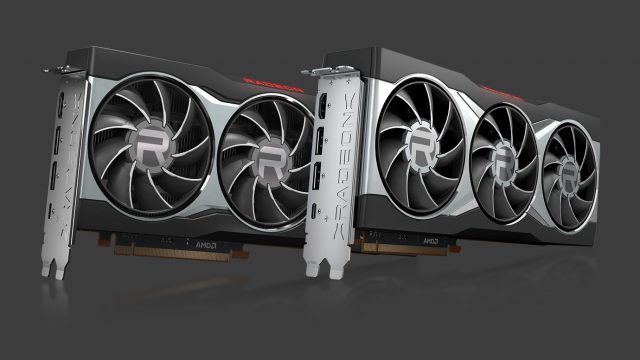AMD today introduced the Radeon RX 6800, 6800 XT, and 6900 XT graphics cards based on its latest RDNA 2 architecture. With a release date in November and prices starting at $580, AMD is aiming to compete directly with NVIDIA’s latest 30-series GPUs. And—better late than never—the RX 6000-series cards include a USB-C port to “power head-mounted displays with just one cable for a modern VR experience.”
Before we dive into details, here’s the release date, price, and basic specs of each card:
| RX 6900 XT | RX 6800 XT | RX 6800 | |
| Price | $1,000 | $650 | $580 |
| Release Date | December 8th, 2020 | November 18th, 2020 | |
| Compute Units | 80 | 72 | 60 |
| Game Clock (GHz) | 2.02 | 2.02 | 1.82 |
| Boost Clock (GHz) | 2.25 | 2.25 | 2.11 |
| Memory (GDDR6) | 16GB | ||
| Connectors | DisplayPort 1.4 w/ DSC*, HDMI 2.2 w/ VRR*, USB-C* | 2x DisplayPort 1.4 w/ DSC, 1x HDMI 2.2 w/ VRR, 1x USB-C | |
| * connector counts unspecified | |||
See a detailed spec comparison here
Based on its new RDNA 2 architecture, AMD is positioning its 6000-series cards to compete directly with Nvida’s latest 30-series GPUs in price, performance, and features.
Infinity Cache, Ray-tracing, and Smart Access Memory
New to the 6000-series cards, ‘Infinity Cache’ is 128MB of memory directly on the GPU die. AMD says the cache acts as a “bandwidth amplifier” for the rest of the card’s memory; 16GB of GDDR6 combined with the 128MB Infinity Cache increases “effective bandwidth” by up to 3.25 times compared to the same amount of memory without the cache.
“This global cache is seen by the entire graphics core, capturing temporal re-use and enabling data to be accessed instantaneously. Leveraging the best high frequency approaches from Zen architecture, AMD Infinity Cache enables scalable performance for the future,” the company explains.
The 6000-series cards also introduce hardware accelerated ray-tracing with one ‘Ray Accelerator’ per Compute Unit. The card’s ray-tracing tech is based on the DirectX 12 Ultimate implementation; AMD says developers can mix and match rasterization and ray-tracing effects, with “an order of magnitude” improvement in ray-tracing operations compared to the last generation of Radeon cards.
The company is also introducing a unique feature for users who pair AMD’s 6000-series GPUs with the company’s own 5000-series Ryzen CPUs. Called Smart Access Memory, the company says the feature allows the CPU to access more of the GPUs memory at once, resulting in a performance boost of a few percentage points depending upon the title. While not a groundbreaking change in performance by itself, it’s essentially ‘free’ (if you have the right combination of hardware), and a smart way to leverage the company’s broader hardware portfolio.
A VirtualLink to the Past
AMD’s own versions of the Radeon RX 6000-series cards include USB-C across the board, which, for VR in particular, would allow the cards to support the VirtualLink standard—a USB-C ‘alt-mode’ which was designed to provide VR headsets with data, power, and video through a single port.
Indeed, the company’s marketing says the port can “power head-mounted displays with just one cable for a modern VR experience,” though the timing is pretty odd given that the VirtualLink standard was initially introduced in 2018 and has since been abandoned. On the flip side, Nvidia was early with support for VirtuaLink by including USB-C ports on its first wave of RTX 20-series GPUs, only to eschew the power on the latest 30-series cards.
Still, as far as we know, a USB-C port on the RX 6000-series cards should mean that VirtualLink devices could work just fine, and headset makers could always devise their own single-cable headset connection based on the card’s USB-C port.
Variable Rate Shading
The RDNA 2 architecture of the 6000-series GPUs also supportS Variable Rate Shading which allows fine-grain control over the shading rate from one frame to the next. This can be used to essentially lower the resolution of some parts of the scene (say dark areas or those without much detail) while maintaining full resolution in important, or high detail parts of the scene.
For VR headsets specifically, the Variable Rate Shading feature opens the door to more precise foveated rendering, which could be static (to match lens distortion) or active (to align with eye movement). AMD hasn’t shown its own VR-specific solution (like Nvidia’s Variable Rate Supersampling) but the underlying tech to support this kind of foveation is there under the hood.
– – — – –
We’ll be looking forward to getting our hands on AMD’s 6000-series cards to see how they handle upcoming high-resolution headsets like HP’s Reverb G2 and memory hungry games like Microsoft Flight Simulator (2020).



